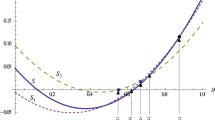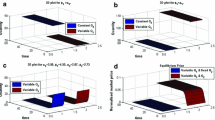Abstract
Small- and medium-sized firms in China have competed passively with advantaged enterprises since 2000, and the prosperity indexes have always been in the recession. This paper aims to find the optimal positioning–pricing strategies for disadvantaged small- and medium-sized firms and explore the complex influence of consumer preference uncertainty in the optimal strategies in duopoly market. In order to do so, the classic Hotelling model is modified to be a heterogeneous duopoly game model under consumer preference uncertainty. By using the backward recurrence algorithm, we first get the optimal equilibrium and then figure out the expected equilibrium solution through mathematical expectation method. The computational results show that disadvantaged enterprises could survive themselves in fierce competition as long as they choose appropriate strategies. In addition, consumer preference uncertainty plays a significant role in affecting the optimal strategy decisions of positioning and pricing in duopoly since producers can hardly obtain complete and perfect information about the market. Specifically, the increased uncertainty of consumer preference generally raises the expected equilibrium price and profit of duopoly enterprises. However, the expected equilibrium profit of the advantaged enterprise in a duopoly decreases with consumer preference uncertainty increasing under certain conditions.


Similar content being viewed by others
Notes
Hotelling assumed the firms producing a homogeneous good at a constant and equal marginal cost.
The unit cost c in this paper can be regarded as the enterprise’s “location cost”, similarly the cost to achieve specific positioning.
In this paper, product quality level is reflected on the failure rate. Specifically, the lower failure rate, the higher level of product quality.
References
Aguirre I, Arroyuelos AMM (2001) On the strategic choice of spatial price policy: the role of the pricing game rules. Econ Bull 12(2):1–7
Anderson EG, Parker GG (2002) Project sourcing decisions in the presence of learning costs [C]. University of Texas Austin, Working paper
Anderson SP, Palma D, Thisse JF (1992) Discrete choice theory of product differentiation Cambridge. The MIT Press, MA
Balasubramanian S, Bhardwaj P (2004) When not all conflict is bad: manufacturing-marketing conflict and strategic incentive design. Manag Sci 50(4):489–502
Banker RD, Khosla I, Sinha KK et al (1998) Quality and competition. Manag Sci 44(9):1179–1192
Bloch F, Manceau D (1999) Persuasive advertising in Hotelling’s model of product differentiation. Int J Ind Org 17(4):557–574
Chen Y, Riordan MH (2007) Price and variety in the spokes model. Econ J 117(522):897–921
Chi WC-Y (2007) Quality choice and the coase problem. Econ Lett 64(1):107–115
Coibion O, Einav L, Hallak JC et al (2007) Equilibrium demand elasticities across quality segments. Int J Ind Org 25(1):13–30
D’aspremont A, Gabszewicz JJ, Thisse JF (1979) On hotellings “stability” in competition. Econometrica 47(5):1145–1150
Diao XJ, Yang DL, Ren YW (2009) Extended Hotelling model-based firms’ competitive strategies [J]. Chin J Manage 6(7): 867–872
Economides N (1999) Quality choice and vertical integration. Int J Ind Org 17(6):903–914
Eston BC, Lipsey RG (1975) The principle of minimum differentiation reconsidered: some new developments in the theory of spatial competition. Rev Econ Stud 42(1):27–49
Gao J (2010) Principle of minimum differentiation or that of maximum differentiation—on the hotelling model and its development. Rev Ind Econ 9(2):27–46
Gronroos C (1983) Strategic management and marketing in the service sector. Marketing Science Institute, Cambridge, Report. pp 83-104
Gu F, Huang PQ, Zhou DS (2002) Strategy of minimum product differentiation under heterogeneity. J Syst Eng 17(5):467–471
Harter JF (1997) Hotelling’s competition with demand location uncertainty. Int J Ind Org 15(3):327–334
Hotelling H (1929) Stability in competition. Econ J 39:41–57
Karmarkar US, Pitbladdo RC (1997) Quality, class, and competition. Manag Sci 43(1):27–39
Kim K, Chhajed D (2002) Product design with multiple quality-type attributes. Manag Sci 48(11):1502–1511
Liu Q, Serfes K (2005) Imperfect price discrimination in a vertical differentiation model. Int J Ind Org 23(5–6):341–354
Lu F, Fan X, Wu J (2005) Research on the reason of price competition in quick-frozen food industry with price-quality value model. Issues Agric Econ S1:79–84
Matsubayashi N (2007) Price and quality competition: the effect of differentiation and vertical integration. Eur J Oper Res 180(2):907–921
Matsubayashi N, Yamada Y (2008) A note on price and quality competition between asymmetric firms. Eur J Oper Res 187(2):571–581
Netz JS, Taylor BA (2002) Maximum or minimum differentiation? Location patterns of retail outlets. Rev Econ Stat 84(1):162–175
Rhee BD (1996) Consumer heterogeneity and strategic quality decisions. Manag Sci 42(2):157–172
Ronald B, Lázló S (1996) Location in the Hotelling duopoly model with demand uncertainty. Eur Econ Rev 40(7):1453–1461
Salop SC (1979) Monopolistic competition with outside goods. Bell J Econ 10(1):141–156
Shaffer G, Zhang ZJ (2002) Competitive one-to-one promotions. Manag Sci 48(9):1143–1160
Sun X, Tian P, Zhao L (2013) Consumer heterogeneity and pricing strategies: a quality-price competition model. J Syst Manag 22(3):349–357
Syam NB, Ruan R, Hess JD et al (2005) Customized products: a competitive analysis. Mark Sci 24(4):569–584
Takatoshi T, Thisse JF (1995) Asymmetric equilibria in spatial competition. Int J Ind Org 13(2):213–227
Tang W, Liang L, Fu Y et al (2006) The analysis of multi-product quality difference discrimination and the optimal quality and pricing strategy under single monopolistic manufacturer. Syst Eng Theory Pract 1:84–90
Wang Q, Cai S, Tang Y (2006) Study of customer utility and enterprise profit based on quality information asymmetry degree. Chin J Manag Sci 14(1):88–93
Acknowledgements
This research was supported by the National Social Science Fund of China (NSSFC) Grant Number 14AZD130. The authors would like to thank the Editor-in-Chief and reviewers for their valuable comments and suggestions.
Author information
Authors and Affiliations
Corresponding author
Ethics declarations
Conflict of interest
The authors declare that they have no conflict of interest.
Ethical approval
This article does not contain any studies with human participants or animals performed by any of the authors.
Additional information
Communicated by Y. Ni.
Rights and permissions
About this article
Cite this article
Yao, Y., Zhao, H., Chen, Y. et al. Positioning–pricing problem of heterogeneous duopoly with uncertain consumer preferences. Soft Comput 22, 5775–5782 (2018). https://doi.org/10.1007/s00500-017-2643-2
Published:
Issue Date:
DOI: https://doi.org/10.1007/s00500-017-2643-2




